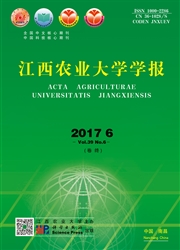

 中文摘要:
中文摘要:
以3种蓼科植物(酸模叶蓼、杠板归、辣蓼)和2个耐铝性不同的油菜品种(湘油杂3号、赣油杂2号)为材料,研究不同科属及同科植物间根系对铝胁迫的反应与根尖细胞壁糖醛酸含量的关系。结果表明,3种蓼科植物的耐铝性显著强于2个油菜品种,其中以酸模叶蓼耐铝性最强,赣油杂2号对铝最敏感。5种植物0~10mm根段积累的铝显著高于10~20mm根段,且油菜0~10mm根段铝含量显著高于蓼科植物。铝处理后,5种植物根尖0~10mm根段细胞壁果胶、半维生素1、半纤维素2含量提高,赣油杂2号提高幅度尤为明显,且无铝对照和铝处理下,2个油菜品种根尖0~10mm根段细胞壁各组分糖醛酸含量显著高于3种蓼科植物尤其是酸模叶蓼。采用1.0mol/LNH3.H2O预处理根尖2h降低细胞壁果胶甲基酯化程度后,5种植物根尖细胞壁对铝的积累量下降,且以2个油菜品种下降幅度最大。铝胁迫下酸模叶蓼根尖细胞壁果胶、半纤维素1和半纤维素2含量较低且提高幅度最小、果胶甲基酯化程度较高等因素降低了铝在根尖的积累,由此缓解了铝对根系伸长的抑制,可能是其耐铝性最强的重要原因。
 英文摘要:
英文摘要:
In this study,3 polygonaceae plants (Polygonum lapathifolium,Polygonum perfoliatum,Polygonum hydropiper) and 2 genotypes of rape (Brassica campestris L.cv.Xiangyou NO.3 and cv.Ganyou NO.2) were used to investigate the relationship between the effects of aluminum (Al) on root elongation and the amount of root apical cell wall polysaccharides.The results showed that the root elongation was decreased with increase of Al concentrations applied,but the inhibition was more conspicuous for rape,indicating higher Al resistance in polygonaceae plants,with the highest Al resistance for Polygonum lapathifolium and Al sensitivity for Ganyou NO.2.In 5 plants,the Al content in 0~10 mm root segments was significantly higher than that in 10~20 mm,and the Al content of 0~10 mm root segments was evidently higher in rape than in polygonaceae plants.The amount of cell wall pectin,hemicellulose 1,hemicellulose 2 in 0~10 mm root segments increased under Al stress,especially in Al-sensitive genotype Ganyou NO.2.Whether the roots were exposed to Al or not,the amount of cell wall polysaccharides in 0~10 mm root segments was higher in 2 rape cultivars than in 3 polygonaceae plants especially for Polygonum lapathifolium.Reducing the methylation degree of pectin in cell walls with 1.0 mol/L NH3·H2O for 2 h,the accumulated amount of Al in cell wall was decreased,especially in 2 rape cultivars.These findings suggested that lower contents of cell wall pectin,hemicellulose 1,hemicellulose 2 and higher degree of pectin methylation in 0~10 mm root segments,which decreased root apical Al content and thereby improved root growth,were important reasons for the highest Al resistance in Polygonum lapathifolium.
 同期刊论文项目
同期刊论文项目
 同项目期刊论文
同项目期刊论文
 期刊信息
期刊信息
